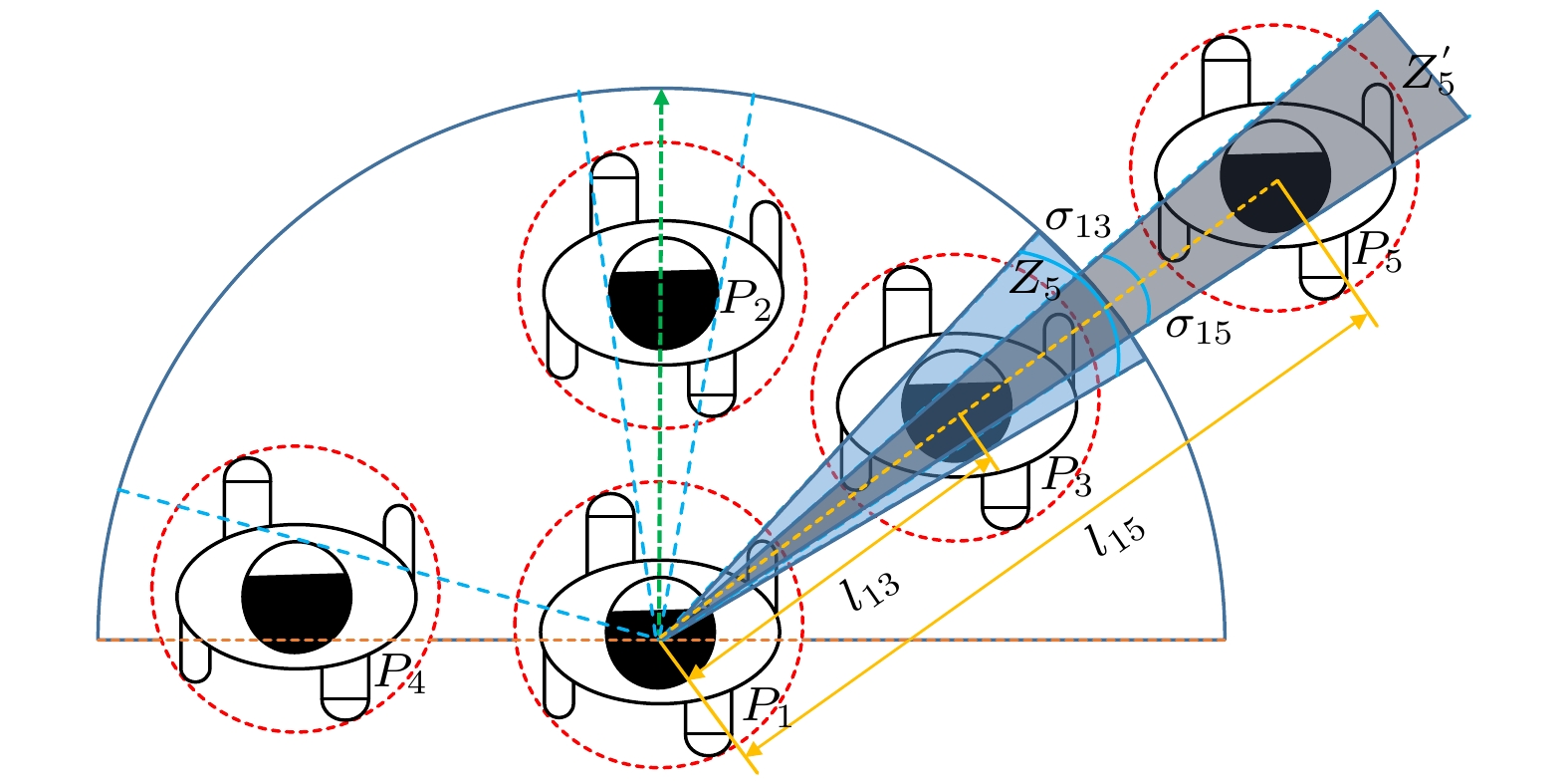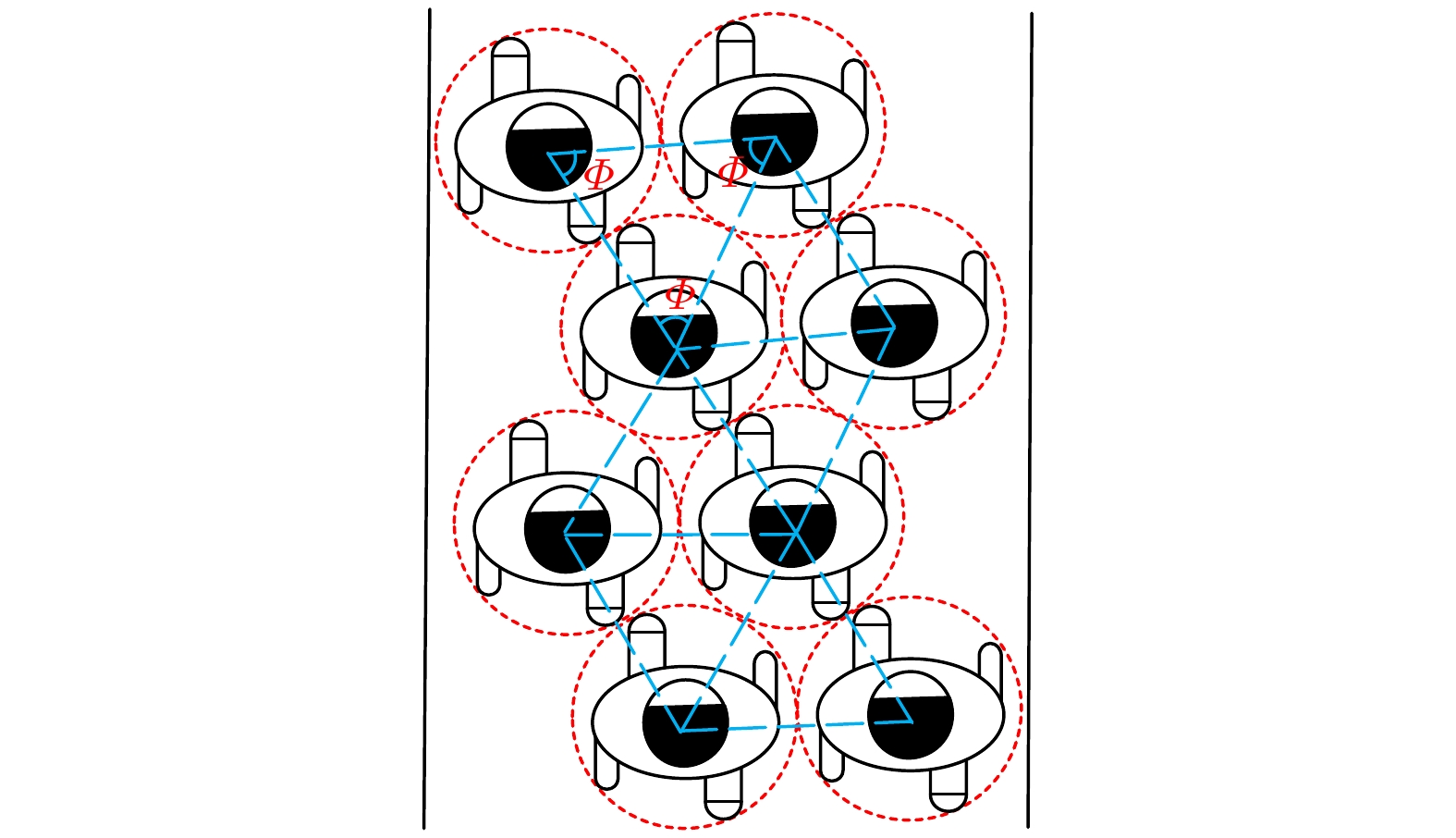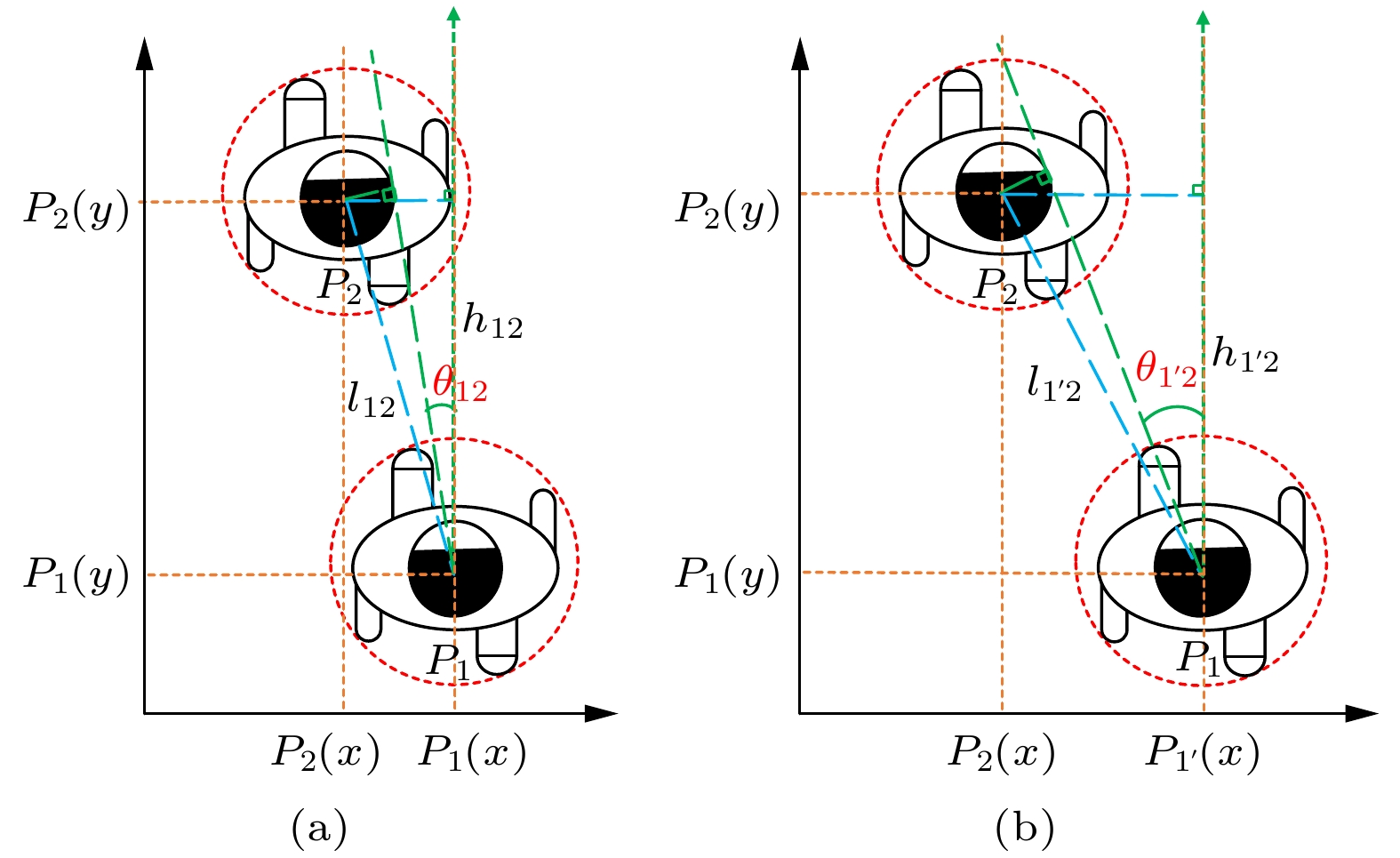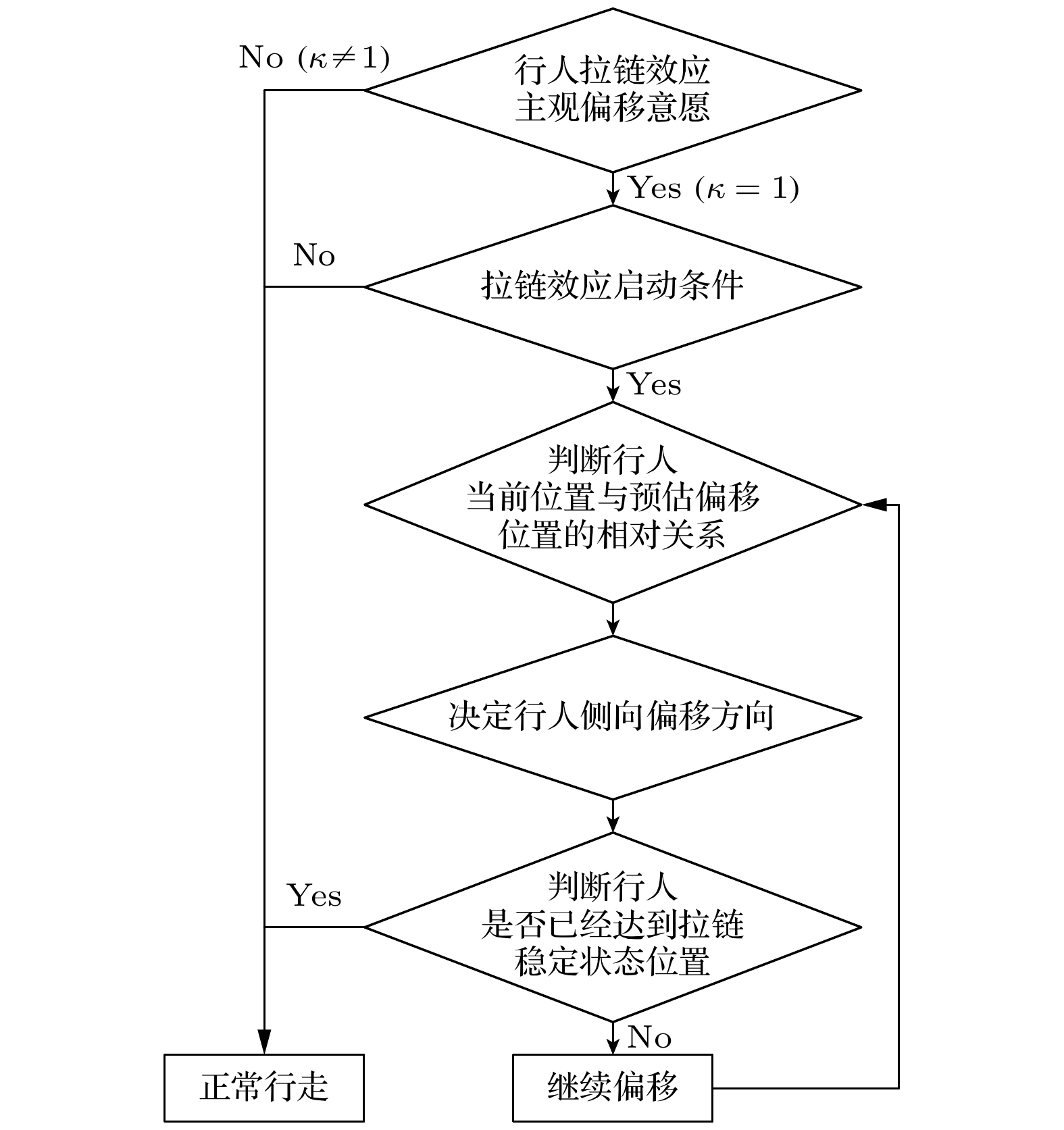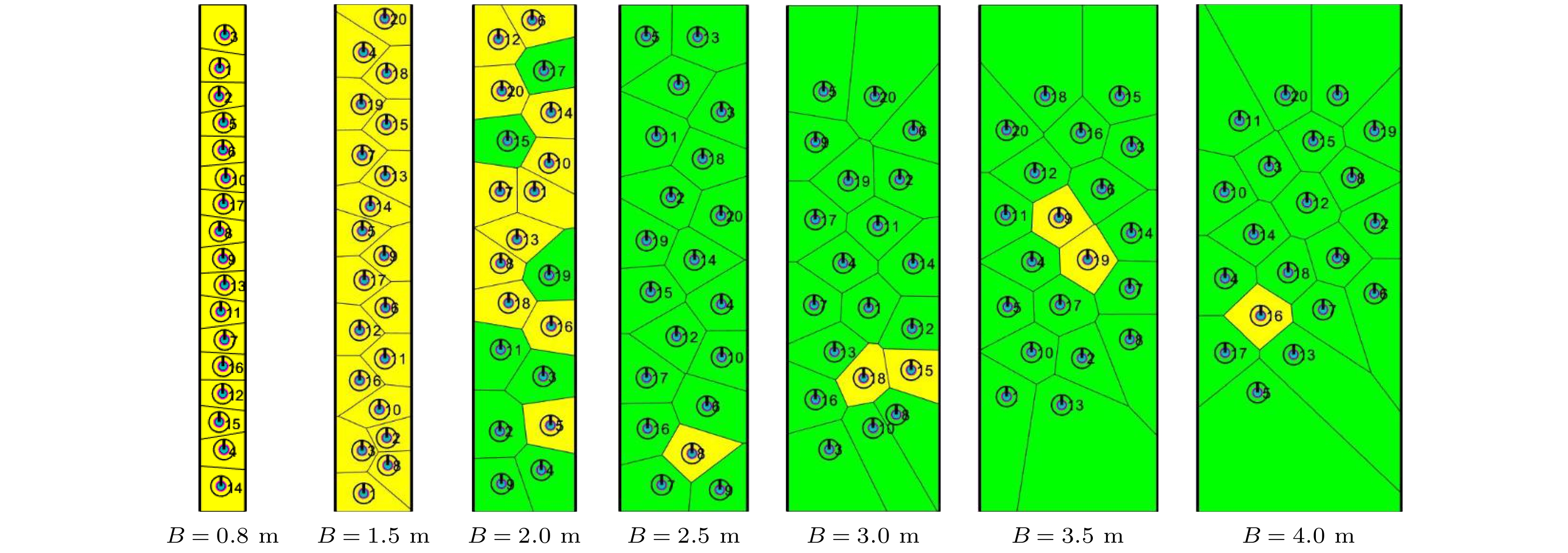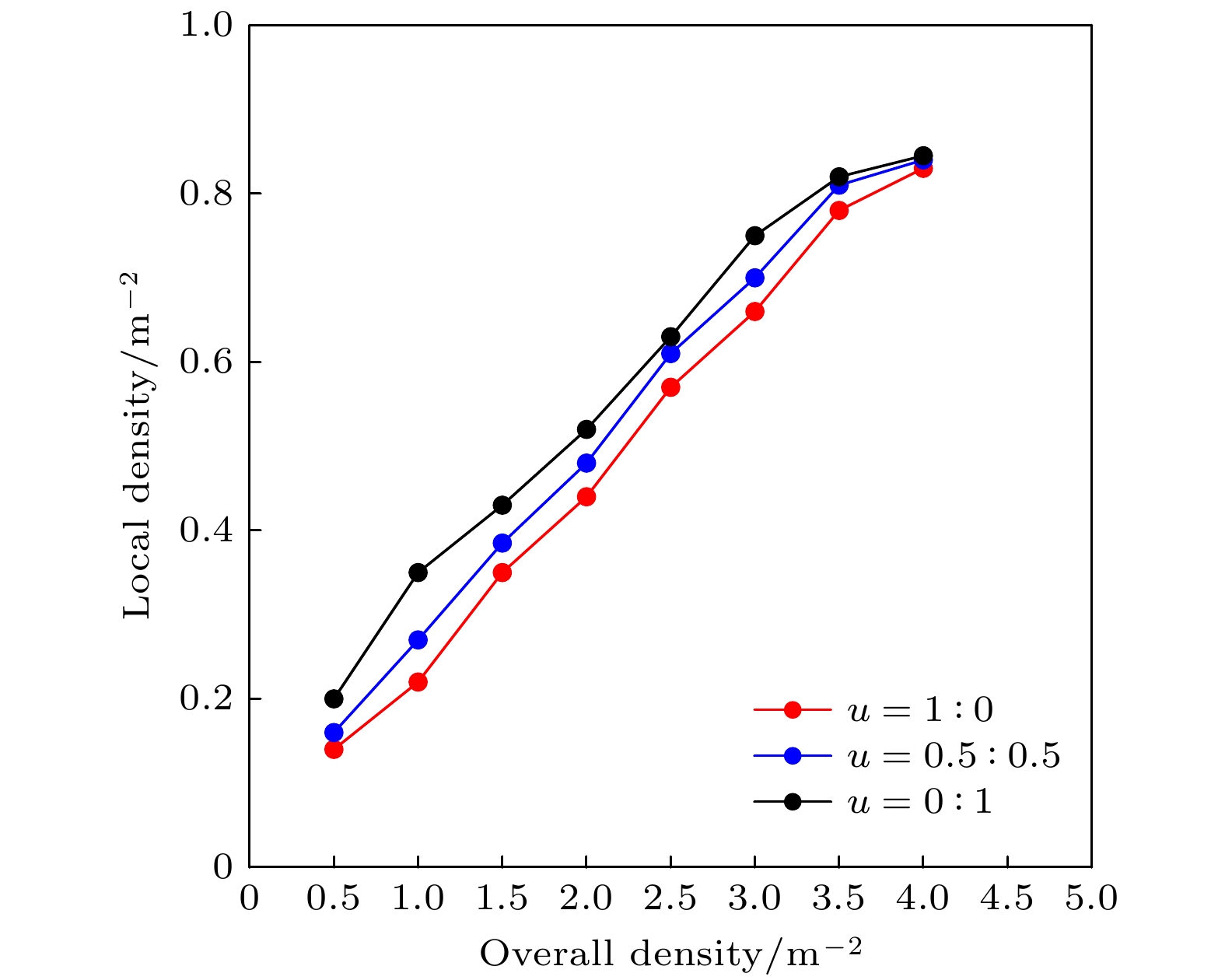-
In this study, the unidirectional pedestrian flow in the corridor is taken as a research object, the generation mechanism of the pedestrian zipper phenomenon is analyzed, and a velocity correction model based on the Voronoi diagram is established for the simulation research. First, the generation mechanism of the pedestrian zipper phenomenon is analyzed from the perspective of optimal visual field and walking comfort of pedestrians. Then the visual attention and visual occlusion of pedestrians are used to describe the factors which affect the zipper deviation during pedestrian movement, the local density of pedestrians is used to describe the walking comfort of pedestrians, the zipper sensitivity coefficient is adopted to describe the willingness of pedestrians to move objectively, and the mechanism of lateral deviation of a single pedestrian is considered to obtain the optimal deviation position of pedestrians. Besides, the Voronoi diagram is introduced to effectively determine the pedestrians surrounding the target pedestrian within the visual field. And the influence of surrounding pedestrians with different distances and directions on the moving velocity of the target pedestrian based on the Voronoi diagram is considered. Then, a velocity correction model of pedestrians based on the Voronoi diagram is constructed, whether the pedestrian has a subjective willingness to deviate is considered, and the deviation rule is embedded to simulate and reproduce the zipper phenomenon of pedestrians. The simulation results truly reproduce the normal pedestrian flow through the corridor and show that our model can overcome the deficiency of the jitter and overlap phenomenon of the traditional social force model. The self-organized pedestrian flow with uniform distribution and the pedestrian zipper effect can also be observed. Furthermore, through the simulation results, we can see that the number of zipper layers for pedestrians is proportional to the width of the corridor. The comparison of simulated pedestrian data with the empirical data indicates that the fundamental diagram of velocity-density relation of our model is in good agreement with the empirical data. A comparison between with and without considering the zipper effect shows that the larger the proportion of pedestrians actively willing to laterally deviate, the more helpful it will be to improve the moving velocity, comfort and space utilization of pedestrians in the corridor.
-
Keywords:
- pedestrian dynamics /
- pedestrian simulation /
- zipper effect /
- Voronoi diagram
[1] Shiwakoti N, Sarvi M 2013 Transp. Res. C, Emerg. Technol. 37 260
 Google Scholar
Google Scholar
[2] Guo R Y, Huang H J, Wong S C 2011 Transp. Res. B, Methodol. 45 490
 Google Scholar
Google Scholar
[3] Duives D C, Daamen W, Hoogendoorn S P 2013 Transp. Res. C, Emerg. Technol. 37 193
 Google Scholar
Google Scholar
[4] Zheng X, Zhong T, Liu M 2009 Build. Environ. 44 437
 Google Scholar
Google Scholar
[5] Blue V J, Adler J L 2000 Transp. Res. Rec. 1710 20
 Google Scholar
Google Scholar
[6] Yue H, Wang S, Jia X L, Li J, Shao C F 2016 Simul.: Trans. Soc. Model. Simul. Int. 92 491
[7] Zhu K, Yang Y, Shi Q 2016 Simul. Model. Pract. Theory. 69 31
 Google Scholar
Google Scholar
[8] Burstedde C, Klauck K, Schadschneider A, Zittartz J 2001 Physica A 295 507
 Google Scholar
Google Scholar
[9] 李明华, 袁振洲, 许痰, 田钧方 2015 64 018903
 Google Scholar
Google Scholar
Li M H, Yuan Z Z, Tian J F 2015 Acta Phys. Sin. 64 018903
 Google Scholar
Google Scholar
[10] Yue H, Zhang B Y, Shao C F, Xing Y 2014 Chin. Phys. B 23 050512
[11] Helbing D, Farkas I, Vicsek T 2000 Nature 407 487
 Google Scholar
Google Scholar
[12] Helbing D, Wemer T 2005 Transp. Sci. 39 1
 Google Scholar
Google Scholar
[13] Hou L, Liu J G, Pan X, Wang B H 2014 Physica A 400 93
 Google Scholar
Google Scholar
[14] Lv W, Song W G, Ma J, Fang Z 2013 IEEE Trans. Intell. Transp. Syst. 14 1753
 Google Scholar
Google Scholar
[15] Zhao Y, Li M, Lu X, Tian L, Yu Z, Huang K, Wang Y, Li T 2017 Physica A 465 175
 Google Scholar
Google Scholar
[16] Jia X L, Yue H, Tian X, Yin H H 2017 Simul.: Trans. Soc. Model. Simul. Int. 93 1013
[17] Seer S, Brandle N, Ratti C 2014 Transp. Res. C, Emerg. Technol. 48 212
 Google Scholar
Google Scholar
[18] Frank G A, Dorso C O 2011 Physica A 390 2135
 Google Scholar
Google Scholar
[19] Seyfried A, Steffen B, Lippert T 2006 Physica A 368 232
 Google Scholar
Google Scholar
[20] Parisi D R, Gilman M, Moldovan H 2009 Physica A 388 3600
 Google Scholar
Google Scholar
[21] Lakoba T I, Kaup D J, Finkelstein N M 2005 Simul. Model. Pract. Theory. 81 339
[22] Li S S, Qian D L, Wang J Z 2012 J. Jilin Univ., Eng. Technol. Ed. 42 623
[23] Johansson A, Helbing D, Shukla P 2007 Adv. Complex Syst. 10 271
[24] Moussaïd M, Helbing D, Garnier S, Johansson A, Combe M, Theraulaz G 2009 Proc. R. Soc. Biol. Sci. 276 2755
 Google Scholar
Google Scholar
[25] Yu WJ, Chen R, Dong L Y, Dai S Q 2005 Phys. Rev. E 72 026112
 Google Scholar
Google Scholar
[26] 曹自强, 赛斌, 吕欣 2020 69 084203
 Google Scholar
Google Scholar
Cao Z Q, Sai B, Lu X 2020 Acta Phys. Sin. 69 084203
 Google Scholar
Google Scholar
[27] Xiao Y, Gao Z Y, Qu Y C, Li X 2016 Transp. Res. C, Emerg. Technol. 68 566
 Google Scholar
Google Scholar
[28] Qu Y C, Xiao Y, Wu J J, Tang T, Gao Z Y 2018 Physica A 492 1153
 Google Scholar
Google Scholar
[29] Moussaïd M, Helbing D, Theraulaz G 2011 Proc. Natl. Acad. Sci. U. S. A. 108 6884
 Google Scholar
Google Scholar
[30] Hoogendoorn S P, Daamen W 2005 Transp. Sci. 39 147
 Google Scholar
Google Scholar
[31] Seyfried A, Passon O, Steffen B, Boltes M, Rupprecht T, Klingsch W 2009 Transp. Sci. 43 395
 Google Scholar
Google Scholar
[32] Porter E, Hamdar S H, Daamen W 2018 Transportmetrica A 14 468
[33] Ren X X, Zhang J, Cao S C, Song W G 2019 J. Stat. Mech. 12 123204
[34] 金辉, 郭仁拥 2019 68 020501
 Google Scholar
Google Scholar
Jin H, Guo R Y 2019 Acta Phys. Sin. 68 020501
 Google Scholar
Google Scholar
[35] [36] 张磊, 岳昊, 李梅, 王帅, 米雪玉 2015 64 060505
 Google Scholar
Google Scholar
Zhang L, Yue H, Li M, Wang S, Mi X Y 2015 Acta Phys. Sin. 64 060505
 Google Scholar
Google Scholar
[37] Older S J 1968 Traff. Eng. Contr. 10 160
[38] Mōri M, Tsukaguchi H 1987 Transp. Res. Part A 21 223
 Google Scholar
Google Scholar
[39] Zhang J, Klingsch W, Schadschneider A, Seyfried A 2011 J. Statist. Mech. - Theory Exp. 6 P06004
[40] [41] Hankin B D, Wright R A 1958 J. Oper. Res. Soc. 9 81
 Google Scholar
Google Scholar
-
图 3 两相邻行人同方向行走形态 (a)行人行走形态; (b)两行人行走并排形式; (c)两行人行走斜列形式; (d)两行人行走直列形式
Figure 3. Walking pattern of two adjacent pedestrians in the same direction: (a) The real single pedestrian walking pattern; (b) two adjacent pedestrians walking side by side; (c) two adjacent pedestrians walking in a diagonal pattern; (d) two adjacent pedestrians walking in a straight line.
图 4 行人拉链现象表现形式 (a)单列行人截图[33]与行人直列形式对比; (b)两列行人截图[33]与行人直列、斜列形式对比; (c)多列行人截图[33]与行人多种排列形式对比
Figure 4. Manifestation of pedestrian zipper phenomenon: (a) The comparison of single-column pedestrian screenshot[33] with pedestrians in-line pattern; (b) the comparison of two-column pedestrian screenshot[33] with pedestrians in-line and diagonal patterns; (c) the comparison of multi-column pedestrian screenshot[33] with multiple arrangement patterns of pedestrians.
图 5 有效视野区域内的行人视野关注和遮挡(橙色遮挡区域是目标行人最为关注和对目标行人影响最大的区域, 蓝色遮挡区域对目标行人的影响较弱)
Figure 5. Pedestrian vision attention and occlusion in the effective vision area (the orange shaded area is the area that the target pedestrian pay the most attention to and has the greatest influence on the target pedestrian, while the blue shaded area has a relatively weak influence on the target pedestrian).
图 7 不同行人局部密度下的拉链现象示意(绿色、黄色、橙色分别表示行人局部密度由低到高) (a)行人局部密度较低时; (b)行人局部密度较高时
Figure 7. The zipper phenomenon of pedestrians under different local density (green, yellow and orange respectively represent the local pedestrian density from low to high):(a) When the local pedestrian density is relatively low; (b) when the local pedestrian density is relatively high.
图 8 不同偏离意愿下的拉链现象示意 (a)窄通道行人偏离意愿较低时; (b)窄通道行人偏离意愿较高时; (c) 宽通道行人偏离意愿较高时
Figure 8. Zipper phenomenon of pedestrians under different deviation intentions: (a) When the deviation intention of pedestrians in narrow corridors is relatively low; (b) when the deviation intention of pedestrians in narrow corridors is relatively high; (c) when the deviation intention of pedestrians in wide corridors is relatively high.
图 14 考虑两侧多个行人的拉链效应偏移情况示意 (a)两侧均满足最佳视野; (b)仅一侧满足最佳视野; (c)两侧妥协后稳定视野
Figure 14. Deviation of zipper effect when consider multiple pedestrians on both sides: (a) Both sides meet the optimum field of vision; (b) only one side satisfies the optimal field of vision; (c) stabilize visual field after compromise on both sides.
表 1 速度修正模型参数取值
Table 1. Parameter values of velocity correction model.
参数 取值 单位 参数 取值 ${v_0}$ 1 ${\rm{m/s}}$ ${k_1}$ 1 ${r_i}$ 0.3 ${\rm{m}}$ ${k_2}$ 0.6 ${d_1}$ 0 ${\rm{m}}$ ${k_3}$ 0.2 ${d_2}$ 0.5 ${\rm{m}}$ ${k_4}$ 0 ${d_3}$ 0.25 ${\rm{m}}$ ${k_5}$ 0.8 $\Delta t$ 0.5 ${\rm{s}}$ ${k_6}$ 0 -
[1] Shiwakoti N, Sarvi M 2013 Transp. Res. C, Emerg. Technol. 37 260
 Google Scholar
Google Scholar
[2] Guo R Y, Huang H J, Wong S C 2011 Transp. Res. B, Methodol. 45 490
 Google Scholar
Google Scholar
[3] Duives D C, Daamen W, Hoogendoorn S P 2013 Transp. Res. C, Emerg. Technol. 37 193
 Google Scholar
Google Scholar
[4] Zheng X, Zhong T, Liu M 2009 Build. Environ. 44 437
 Google Scholar
Google Scholar
[5] Blue V J, Adler J L 2000 Transp. Res. Rec. 1710 20
 Google Scholar
Google Scholar
[6] Yue H, Wang S, Jia X L, Li J, Shao C F 2016 Simul.: Trans. Soc. Model. Simul. Int. 92 491
[7] Zhu K, Yang Y, Shi Q 2016 Simul. Model. Pract. Theory. 69 31
 Google Scholar
Google Scholar
[8] Burstedde C, Klauck K, Schadschneider A, Zittartz J 2001 Physica A 295 507
 Google Scholar
Google Scholar
[9] 李明华, 袁振洲, 许痰, 田钧方 2015 64 018903
 Google Scholar
Google Scholar
Li M H, Yuan Z Z, Tian J F 2015 Acta Phys. Sin. 64 018903
 Google Scholar
Google Scholar
[10] Yue H, Zhang B Y, Shao C F, Xing Y 2014 Chin. Phys. B 23 050512
[11] Helbing D, Farkas I, Vicsek T 2000 Nature 407 487
 Google Scholar
Google Scholar
[12] Helbing D, Wemer T 2005 Transp. Sci. 39 1
 Google Scholar
Google Scholar
[13] Hou L, Liu J G, Pan X, Wang B H 2014 Physica A 400 93
 Google Scholar
Google Scholar
[14] Lv W, Song W G, Ma J, Fang Z 2013 IEEE Trans. Intell. Transp. Syst. 14 1753
 Google Scholar
Google Scholar
[15] Zhao Y, Li M, Lu X, Tian L, Yu Z, Huang K, Wang Y, Li T 2017 Physica A 465 175
 Google Scholar
Google Scholar
[16] Jia X L, Yue H, Tian X, Yin H H 2017 Simul.: Trans. Soc. Model. Simul. Int. 93 1013
[17] Seer S, Brandle N, Ratti C 2014 Transp. Res. C, Emerg. Technol. 48 212
 Google Scholar
Google Scholar
[18] Frank G A, Dorso C O 2011 Physica A 390 2135
 Google Scholar
Google Scholar
[19] Seyfried A, Steffen B, Lippert T 2006 Physica A 368 232
 Google Scholar
Google Scholar
[20] Parisi D R, Gilman M, Moldovan H 2009 Physica A 388 3600
 Google Scholar
Google Scholar
[21] Lakoba T I, Kaup D J, Finkelstein N M 2005 Simul. Model. Pract. Theory. 81 339
[22] Li S S, Qian D L, Wang J Z 2012 J. Jilin Univ., Eng. Technol. Ed. 42 623
[23] Johansson A, Helbing D, Shukla P 2007 Adv. Complex Syst. 10 271
[24] Moussaïd M, Helbing D, Garnier S, Johansson A, Combe M, Theraulaz G 2009 Proc. R. Soc. Biol. Sci. 276 2755
 Google Scholar
Google Scholar
[25] Yu WJ, Chen R, Dong L Y, Dai S Q 2005 Phys. Rev. E 72 026112
 Google Scholar
Google Scholar
[26] 曹自强, 赛斌, 吕欣 2020 69 084203
 Google Scholar
Google Scholar
Cao Z Q, Sai B, Lu X 2020 Acta Phys. Sin. 69 084203
 Google Scholar
Google Scholar
[27] Xiao Y, Gao Z Y, Qu Y C, Li X 2016 Transp. Res. C, Emerg. Technol. 68 566
 Google Scholar
Google Scholar
[28] Qu Y C, Xiao Y, Wu J J, Tang T, Gao Z Y 2018 Physica A 492 1153
 Google Scholar
Google Scholar
[29] Moussaïd M, Helbing D, Theraulaz G 2011 Proc. Natl. Acad. Sci. U. S. A. 108 6884
 Google Scholar
Google Scholar
[30] Hoogendoorn S P, Daamen W 2005 Transp. Sci. 39 147
 Google Scholar
Google Scholar
[31] Seyfried A, Passon O, Steffen B, Boltes M, Rupprecht T, Klingsch W 2009 Transp. Sci. 43 395
 Google Scholar
Google Scholar
[32] Porter E, Hamdar S H, Daamen W 2018 Transportmetrica A 14 468
[33] Ren X X, Zhang J, Cao S C, Song W G 2019 J. Stat. Mech. 12 123204
[34] 金辉, 郭仁拥 2019 68 020501
 Google Scholar
Google Scholar
Jin H, Guo R Y 2019 Acta Phys. Sin. 68 020501
 Google Scholar
Google Scholar
[35] [36] 张磊, 岳昊, 李梅, 王帅, 米雪玉 2015 64 060505
 Google Scholar
Google Scholar
Zhang L, Yue H, Li M, Wang S, Mi X Y 2015 Acta Phys. Sin. 64 060505
 Google Scholar
Google Scholar
[37] Older S J 1968 Traff. Eng. Contr. 10 160
[38] Mōri M, Tsukaguchi H 1987 Transp. Res. Part A 21 223
 Google Scholar
Google Scholar
[39] Zhang J, Klingsch W, Schadschneider A, Seyfried A 2011 J. Statist. Mech. - Theory Exp. 6 P06004
[40] [41] Hankin B D, Wright R A 1958 J. Oper. Res. Soc. 9 81
 Google Scholar
Google Scholar
Catalog
Metrics
- Abstract views: 9410
- PDF Downloads: 114
- Cited By: 0















 DownLoad:
DownLoad:




